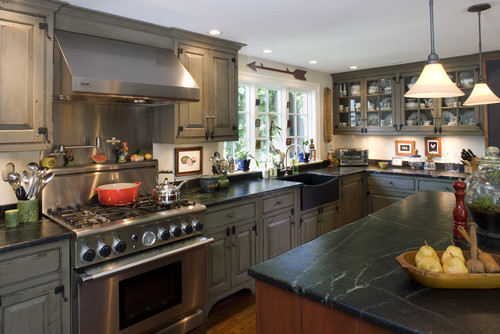The name 'Soapstone' is used to describe many different kinds and colors of stone that are primarily made up of Talc. These forms of soapstone are used for carving due to its softness.
The talc in soapstone feels soft to the touch, it gives the smooth feeling of rubbing a piece of dry soap. Thus the name. No, it doesn't lather up and isn't good to wash with. :)
 |
| Soapstone countertops and gorgeous sink. Designed by Anthony Catalfano Interiors. |
Soapstone is generally 300-400 million years old depending on what country it is quarried from. It is quarried from all over the world. The Soapstone we use here in Utah is primarily from Brazil.
 |
| The Cristo Redentor in Rio de Janeiro is made of Soapstone & reinforced concrete. |
You will also see Soapstone widely used in wood stoves, fireplace liners, masonry heater fireplaces, pizza ovens, etc. It has remarkable natural heat retention. It heats up quickly and then slowly radiates the heat evenly for hours on end, even after the fire has gone out!
Historically Soapstone has been used around the world for tools, vases, sculptures, carafes, goblets, fireplaces, bed warmers, building blocks, urns, grave markers and more.
Currently the most popular ways to use Soapstone are for countertops, sinks, ovens, fireplaces and stoves.
 |
| Photo: House Beautiful |
This includes the mineral oil that you put on it. If you decide you don't like the darker appearance it can be refinished and the Soapstone will go back to looking like it did in it's natural state.
I highly recommend using mineral oil or beeswax on Soapstone countertops. This is purely cosmetic. Soapstone will naturally darken with age. By using mineral oil or beeswax on Soapstone it brings out the dark, rich colors in the stone. Treating it initially just speeds up the aging process. The mineral oil or beeswax will also work as a protective sealing layer to the surface of the stone.
That being said...some people never apply anything to the stone, it does eventually take on it's own natural patina with regular use.
 |
| Photo: Dorado Soapstone |
If you are considering Soapstone please contact us for a free estimate. We are also happy to talk through any questions and/or concerns you may have.







No comments:
Post a Comment